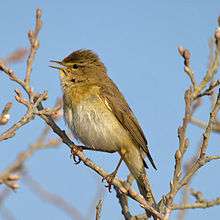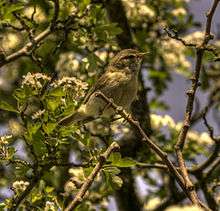Willow warbler
The willow warbler (Phylloscopus trochilus) is a very common and widespread leaf warbler which breeds throughout northern and temperate Europe and the Palearctic, from Ireland east to the Anadyr River basin in eastern Siberia. It is strongly migratory, with almost all of the population wintering in Sub-Saharan Africa.[2][3]
| Willow warbler | |
|---|---|
 | |
| Scientific classification | |
| Kingdom: | Animalia |
| Phylum: | Chordata |
| Class: | Aves |
| Order: | Passeriformes |
| Family: | Phylloscopidae |
| Genus: | Phylloscopus |
| Species: | P. trochilus |
| Binomial name | |
| Phylloscopus trochilus | |
| Subspecies | |
 | |
| Yellow: Breeding (summer only) Blue: Non-breeding winter visitor Cross-hatched: migration. | |
| Synonyms | |
| |
It is a bird of open woodlands with trees and ground cover for nesting, including most importantly birch, alder, and willow habitats. The nest is usually built in close contact with the ground, often in low vegetation. Like most Old World warblers (Sylviidae), this small passerine is insectivorous.[3] In northern Europe, it is one of the first warblers to return in the spring though is later than the closely related chiffchaff.[3]
Description
It is a typical leaf warbler in appearance, 11–12.5 cm long and 7–15 g weight. It is greenish brown above and off-white to yellowish below; the wings are plain greenish-brown with no wingbars. Juveniles are yellower below than adults. It is very similar to the chiffchaff, but non-singing birds can be distinguished from that species by their paler pinkish-yellow legs (dark brown to blackish in chiffchaff), longer paler bill, more elegant shape and longer primary projection (wingtip). Its song is a simple repetitive descending whistle, while the contact call is a disyllabic 'hoo-eet', distinct from the more monosyllabic 'hweet' of chiffchaffs.[2][3][4][5]
Subspecies
Three subspecies are accepted, with a partly clinal reduction in green and yellow plumage tones from west to east, with central birds browner and easternmost birds predominantly greyish:[2]
- Phylloscopus trochilus trochilus (Linnaeus, 1758). Breeds Europe (from the Pyrenees and Alps northward) except northern Scandinavia, winters west Africa.
- Phylloscopus trochilus acredula (Linnaeus, 1758). Breeds northern Scandinavia east to western Siberia, winters central Africa.
- Phylloscopus trochilus yakutensis (Ticehurst, 1935). Breeds eastern Siberia, winters eastern and southern Africa.
Behaviour
All populations are highly migratory, with the subspecies P. t. yakutensis migrating up to 12,000 km from eastern Siberia to southern Africa along the Asian - East African Flyway, one of the longest migrations of any for a bird of its size.[2][4] Approximate timings are:
- October to March: wintering in sub Saharan Africa.
- Mid March to mid-May: migrates and arrives in the breeding range.
- Late April to August: breeding season, usually only one brood but rarely two.
- August to October: migrates back to Africa.
Status and conservation

Willow warblers prefer young, open, scrubby woodland with small trees, including human-altered habitats such as coppice and young plantations up to 10–20 years old. High amounts of birch, alder and willow, with good lichen amounts, and water features (e.g. streams), fields with large amounts of bracken and mosses, and patches of low bramble (for nest cover) are preferred, but it will use a wide range of other species, including young or open coniferous forests.[4][6] Incorporating woodland ride edge thickets is beneficial, as is 15 metre woodland edges of varying structure and height. They prefer damp woodland areas. Thicket forming shrubs like blackthorn provide pockets of habitat. Deer browsing can degrade the required low cover.
The highest population densities are found in Scandinavia (where it is the commonest bird of any), with up to 1,100 pairs per square kilometre, and a total population in Sweden and Finland of 24 million pairs. Lower densities occur further east, with peak densities of 27 pairs per square kilometre in central Siberia. Even lower densities are found on the southern edge of the breeding range, with just 9 pairs per square kilometre in Switzerland, and a total of just 100 pairs in the whole of northern Spain.[2]
In England this species has on average decreased in population by 70% within the last 25 years, with the biggest declines in the southeast. In Scotland some increases have occurred. The Forestry Commission offers grants under a scheme called England's Woodland Improvement Grant (EWIG); as does Natural Englands Environmental Stewardship Scheme.[6]
History
The willow warbler was first scientifically described by Carl Linnaeus in his landmark 1758 10th edition of Systema Naturae under the genus Motacilla.[7] and then transferred to the genus Phylloscopus (of which it is the type species) by Boie in 1826.[8] The scientific name is from Ancient Greek. The genus name Phylloscopus is from phullon, "leaf", and skopos, "seeker" (from skopeo, "to watch"), and the specific trochilus is from trokhilos, "wren".[9]
Before the English name was standardised to willow warbler by William Yarrell in 1843, it was sometimes called "willow wren".[10]
References
- BirdLife International (2013). "Phylloscopus trochilus". IUCN Red List of Threatened Species. 2013. Retrieved 26 November 2013.CS1 maint: ref=harv (link)
- Hoyo, J. del; et al., eds. (2006). Handbook of the Birds of the World, vol. 11. Barcelona: Lynx Edicions. pp. 649. ISBN 84-87334-22-9.
- Baker, Kevin (1997). Warblers of Europe, Asia and North Africa (Helm Identification Guides). pp. 256–259. ISBN 0-7136-3971-7.
- Snow, D. W.; Perrins, C. M. (1998). The Birds of the Western Palearctic (Concise ed.). Oxford: Oxford University Press. ISBN 0-19-854099-X.
- Ageing and sexing (PDF) by Javier Blasco-Zumeta
- RSPB Woodland Management For Birds – Willow Warbler
- Linnaeus, Carl (1758). Systema naturae per regna tria naturae, secundum classes, ordines, genera, species, cum characteribus, differentiis, synonymis, locis. Tomus I. Editio decima, reformata (in Latin). Holmiae. (Laurentii Salvii). p. 188.
- Boie, F. Isis (von Oken) 19 (10): 972, 1826.
- Jobling, James A (2010). The Helm Dictionary of Scientific Bird Names. London: Christopher Helm. pp. 305, 394. ISBN 978-1-4081-2501-4.
- Lockwood, W. B. (1984). The Oxford Book of British Bird Names. Oxford University Press ISBN 0-19-214155-4.
External links
| Wikimedia Commons has media related to Phylloscopus trochilus. |
- Willow warbler videos, photos & sounds on the Internet Bird Collection
- Feathers of the willow warbler
- Willow warbler - Species text in The Atlas of Southern African Birds.
